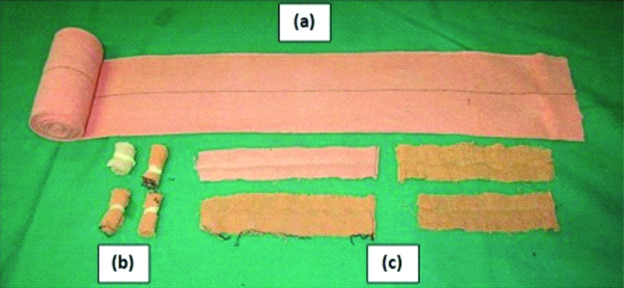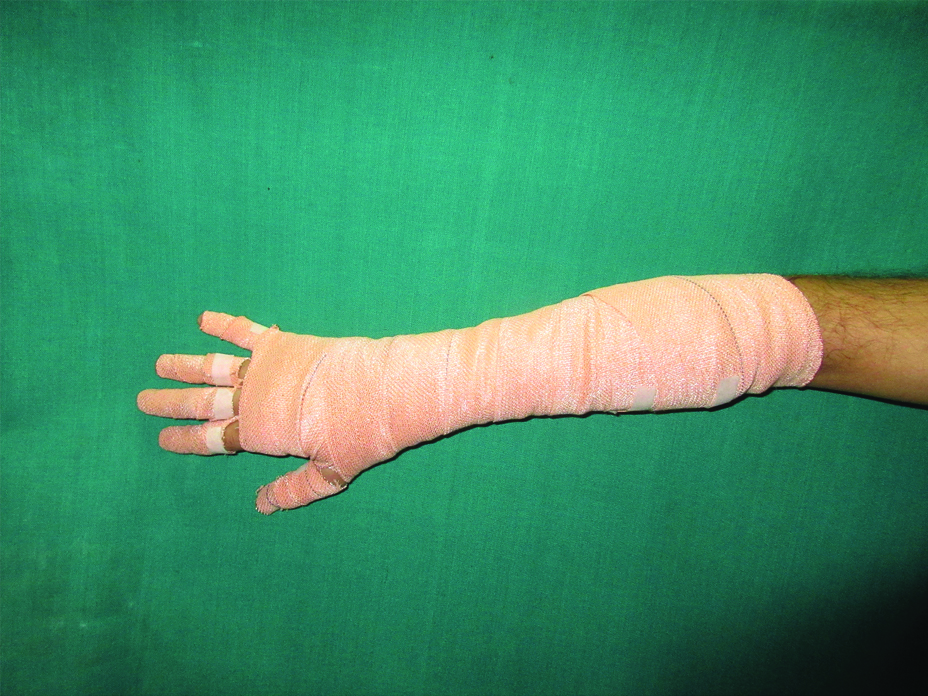Pressure Bandaging for Fingers Using Finger Crepe: An Economic and Effective Method
Manoj Bachhav1, Raghav Shrotriya2, Vinita Puri3
1 Senior Resident, Department of Plastic Surgery, Seth Gordhandas Sunderdas Medical College and King Edward Memorial Hospital, Mumbai, Maharashtra, India.
2 Senior Resident, Department of Plastic Surgery, Seth Gordhandas Sunderdas Medical College and King Edward Memorial Hospital, Mumbai, Maharashtra, India.
3 Professor and Head, Department of Plastic Surgery, Seth Gordhandas Sunderdas Medical College and King Edward Memorial Hospital, Mumbai, Maharashtra, India.
NAME, ADDRESS, E-MAIL ID OF THE CORRESPONDING AUTHOR: Dr. Raghav Shrotriya, Senior Resident, Department of Plastic Surgery, Gynaecology Wing, 2nd Floor, King Edward Memorial Hospital, Parel, Mumbai-400012, Maharashtra, India.
E-mail: dr.raghav.s@gmail.com
Finger oedema, Hand burns, Hand surgery, Pressure bandage
Dear Editor,
Trauma to any part of body leads to tissue oedema, which in turn affects the function by reducing joint movements and augmenting pain. It is more evident in fingers and hand. Pressure bandaging is routinely used for patients of hand burn and hand injury to counter oedema and stiffness which lead to reduced function [1]. Along with hand, the fingers also require pressure bandaging. Patients with hand burns require long term application and frequent change of bandage due to soakage by exudates [2].
An ideal pressure bandage for fingers should be easily available, cost effective, amenable to sterilisation for intraoperative use, washable for reusability, adequate tensile strength and appropriate stretch ability to avoid inadvertent neurovascular compromise [3]. In most centres, Coban® bandage is used in the commercially available form for this purpose [4]. Once soaked, it needs to be discarded and cannot be washed. It also has a limitation of not being available as a sterile material.
We suggest the use of finger wraps cut from the 4” and 6” crepe bandage. These wraps can be easily cut by the support staff and fastened using rubber band for storage [Table/Fig-1]. They can also be autoclaved to be used as sterile dressings, intraoperatively or for patients of hand burn injury, while also retaining their elasticity [5]. Though, not in direct contact with the wound, sterility of a pressure bandage is desirable especially in immediate postoperative period or when other wounds might be open.
a) 4” crepe bandage roll; b) cut finger crepes rolled and fastened using rubber band; c) unfastened finger crepes.

Regular length of 4” or 6” crepe bandage roll is around 400 cm. A single roll of crepe bandage can provide between 80-110 pieces of finger wraps, depending on the width of the roll, each wrap being around 15x3.5 cm in size. Smaller widths can also be made which are especially useful after release and resurfacing of finger contractures in children. Routinely, when a crepe bandage is applied for the upper limb from palm upwards, once the role has covered the requisite area, the remaining length, if rolled distally as a second layer, may be counterproductive. This extra length that needs to be discarded can be cut into pieces for finger crepe.
One piece of extra crepe can provide 15-20 pieces of finger wraps, some of which can be used immediately and extra pieces can be kept for future use.
It is the authors’ observation that in patients who have undergone suturing over the fingers, or have burn or escharotomy wounds, these wraps provide early pain relief, decrease oedema while still allowing the much needed mobilisation. The average cost of 10 finger crepes (15×3.5 cm in size) if made from crepe bandage comes out to be about 0.3 USD as compared to Coban® wrap which is approximately 12 times as expensive (3.74 USD, size adjusted). Also, the finger crepe can be washed and reused in case of soakage, which is a definite advantage over Coban® wrap. Though, not a preferable practice, this might be necessitated in limited resource setting. Unlike Coban® wraps, the finger crepe can be sterilised using autoclaving. In contrast to Coban bandages which are self adhering, these wraps are held by application of micropore tape (applied over a small part of the circumference, just enough to hold), which is readily available or may be held by a single suture or stapler when used intraoperatively in cases such as finger contracture release, syndactyly release, finger suturing and grafting [Table/Fig-2]. Another important advantage is that if there is oedema, crepe can loosen up avoiding danger of neurovascular compromise.
Finger crepe along with crepe bandage applied to a hand burn.

It is routine practice in our operation theater and burn ward to keep autoclaved tray ready with finger crepe bandages and we have been using this method for more than 25 years with the patients achieving clinical relief from pain and oedema. In authors’ opinion, this technique is a suggestion of adaptation to prevalent practice that can be used in areas that are under resourced. The authors suggest that in low resource settings where crepe bandage is readily available, it can be used as a cheaper and reusable pressure bandage for fingers.
[1]. Park WJ, Jung SJ, Joo SY, Jang KU, Seo CH, Jun AY, Effects of a modified hand compression bandage for treatment of post-burn hand edemaAnn Rehabil Med. 2016 40(2):341-40.10.5535/arm.2016.40.2.34127152286 [Google Scholar] [CrossRef] [PubMed]
[2]. Moore ML, Dewey WS, Richard RL, Rehabilitation of the burned handHand Clin 2009 25(4):529-41.10.1016/j.hcl.2009.06.00519801125 [Google Scholar] [CrossRef] [PubMed]
[3]. Ward RS, Reddy R, Brockway C, Hayes-Lundy C, Mills P, Uses of coban selfadherent wrap in management of postburn hand grafts: case reportsJ Burn Care Rehabil 1994 15(4):364-69.10.1097/00004630-199407000-000137929520 [Google Scholar] [CrossRef] [PubMed]
[4]. Lowell M, Pirc P, Ward RS, Lundy C, Wilhelm DA, Reddy R, Effect of 3M Coban self-adherent wraps on edema and function of the burned hand: a case studyJ Burn Care Rehabil 2003 24(4):253-58.10.1097/01.BCR.0000075846.92114.AD14501426 [Google Scholar] [CrossRef] [PubMed]
[5]. Torra Bou JE, Rueda López J, Blanco Blanco J, Torres Ballester J, Toda Lloret L, Venous ulcers. Multilayer compression system or crepe bandage? Comparative study on effectiveness, cost, and impact on quality of lifeRev Enferm 2003 26(6):59-66. [Google Scholar]